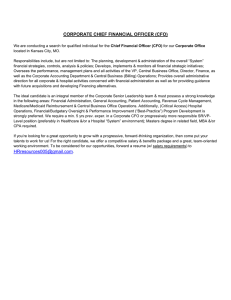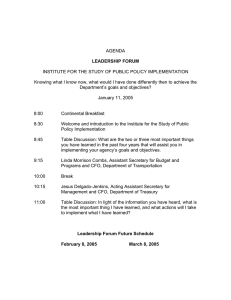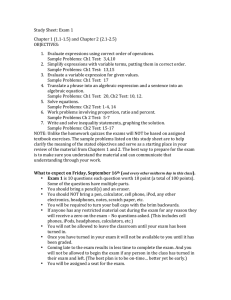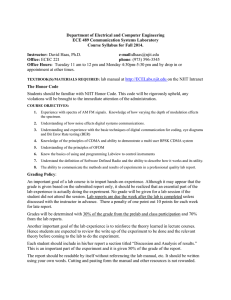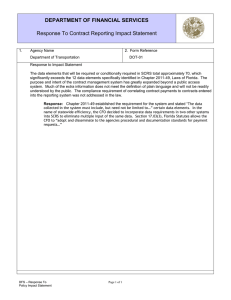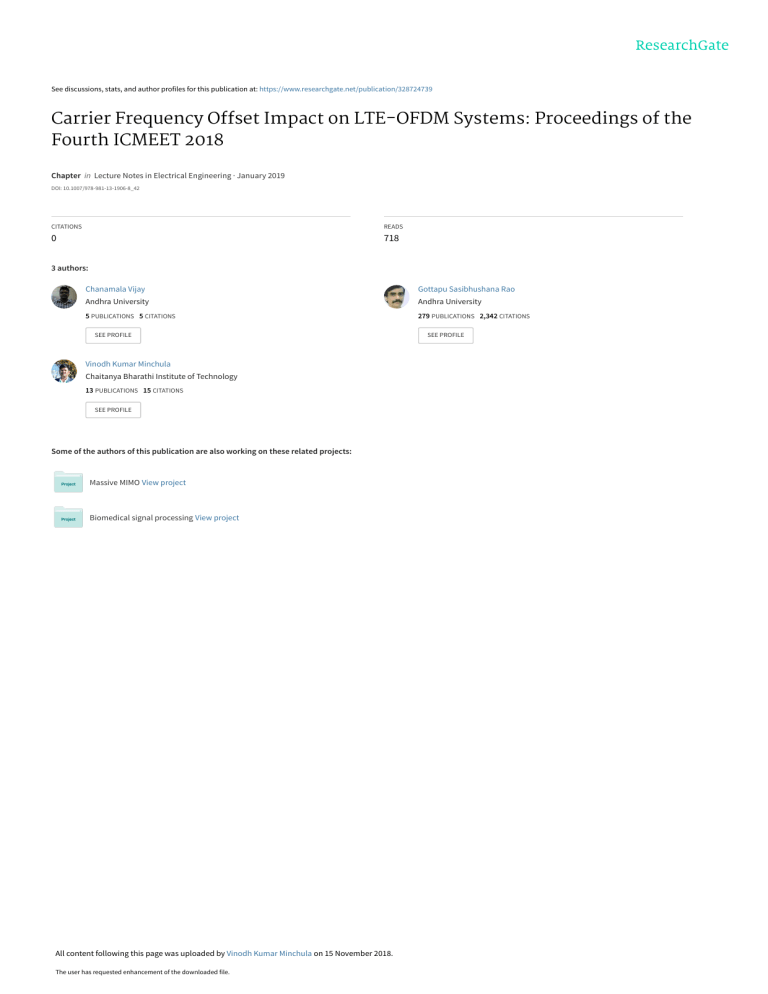
See discussions, stats, and author profiles for this publication at: https://www.researchgate.net/publication/328724739 Carrier Frequency Offset Impact on LTE-OFDM Systems: Proceedings of the Fourth ICMEET 2018 Chapter in Lecture Notes in Electrical Engineering · January 2019 DOI: 10.1007/978-981-13-1906-8_42 CITATIONS READS 0 718 3 authors: Chanamala Vijay Gottapu Sasibhushana Rao Andhra University Andhra University 5 PUBLICATIONS 5 CITATIONS 279 PUBLICATIONS 2,342 CITATIONS SEE PROFILE Vinodh Kumar Minchula Chaitanya Bharathi Institute of Technology 13 PUBLICATIONS 15 CITATIONS SEE PROFILE Some of the authors of this publication are also working on these related projects: Massive MIMO View project Biomedical signal processing View project All content following this page was uploaded by Vinodh Kumar Minchula on 15 November 2018. The user has requested enhancement of the downloaded file. SEE PROFILE Carrier Frequency Offset Impact on LTE-OFDM Systems Chanamala Vijay, Gottapu Sasibhushana Rao and Minchula Vinodh Kumar Abstract The Carrier Frequency Offset (CFO) occurs in an LTE-OFDM system due to the mismatched frequencies on the received signal and the local oscillator at the receiver. The reason for this offset is caused due to the Doppler shift resulting in Inter-Carrier Interference (ICI) and Inter-Symbol Interference (ISI) where its performance degrades with an increase in the Bit Error Rate (BER). This paper analyses the BER performance for various modulations with different ranges of frequency offset. The results indicate that for BPSK modulation technique, it provides better BER at null carrier frequency offset when compared to other modulation techniques (QPSK, 8PSK, 16PSK, 32PSK, 64PSK, and 16QAM) and other ranges of offset frequency. Keywords OFDM · CFO · ICI · ISI · SNR · BER 1 Introduction OFDM is an established modulation scheme in current broadband wireless mobile communication systems due to its high spectral efficiency and robustness against multipath interference. Its system model with offset is as shown in Fig. 1. The notable drawback of the OFDM system is its sensitivity to carrier frequency offset caused by oscillator inaccuracies and the Doppler shift in the channel. Doppler shift occurs when the transmitter of a signal is moving in relation to the receiver [1–3]. The relative movement shifts the frequency of the signal, making it different at the receiver than the transmitter. CFO causes frequency differences between the transmitter and C. Vijay (B) · G. Sasibhushana Rao · M. V. Kumar Andhra University College of Engineering (A) Andhra University, Visakhapatnam 530003, Andhra Pradesh, India e-mail: vchanamala@gmail.com G. Sasibhushana Rao e-mail: sasigps@gmail.com M. V. Kumar e-mail: vinodh.edu@gmail.com © Springer Nature Singapore Pte Ltd. 2019 G. Panda et al. (eds.), Microelectronics, Electromagnetics and Telecommunications, Lecture Notes in Electrical Engineering 521, https://doi.org/10.1007/978-981-13-1906-8_42 401 402 S(k) C. Vijay et al. S/P Signal Mappe r B(k) Adding B(n) Adding Cyclic Pilots Prefix and and P/S IFFT b(t) DAC Channel k(t) z(t) j 2πδ 1 x 0 δ 1= ε e X Δf Gaussian noise w(t) a(n) A(k) S(k) P/S Signal Demappe r FFT Remove Cyclic Prefix and S/P ADC a(t) r(t) Fig. 1 Block diagram of OFDM with frequency offset receiver oscillator, Doppler shift of mobile channels, decrease in power efficiency, phase shift, and oscillator instabilities. Merits and Demerits of OFDM are listed as below [4, 5] (i) (ii) (iii) (iv) Very easy and efficient in dealing with multipath. Robust against narrowband interference. Sensitive to frequency offset and phase noise. Peak to average power ratio reduces the power efficiency of RF amplifier at the transmitter. 2 Frequency Offset In modern communication system engineering, CFO is shifting of the radio frequency as shown in Fig. 2. The CFO destroys the orthogonality of the carriers and causes Inter-Symbol Interference (ISI) and Inter-Channel Interference (ICI) [6–8]. There are two categories of CFO, they are as follows: Magnitude Carrier Frequency Offset Fig. 2 Carrier frequency offset (ε) Frequency Carrier Frequency Offset Impact on LTE-OFDM Systems 403 (1) Fractional CFO, which introduces ICI and degrades the performance of Bit Error Rate (BER) and (2) Integer CFO, which introduces the cyclic shift of data subcarriers and phase change. The OFDM transmitter and receiver with CFO equations can be determined as At transmitter b(n) k−1 j2π xm 1 B(m)e X X m0 (1) At receiver a(n) b(n)e j2π xε X + w(n) (2) where ε Normalized Carrier Frequency offset, ε 1f f X T and w(n) XT Noise of the signal, N number of subcarriers. Channel carrier frequency offset is added to the received signal A(k) B(k)S(0) + N −1 B(l)S(l − k) + W (k) (3) l0,lk where k = 0, 2, …, N − 1. Due to the carrier frequency offset, the Bit Error Rate (BER) performance degrades as the signal-to-noise ratio (SNR) increases for the selective range of CFO [9, 10]. 3 Results This section illustrates the behavior of OFDM with different CFO ranges in terms of BER versus SNR for various modulations such as BPSK, QPSK, 8PSK, 16PSK, 32PSK, 64PSK, and 16QAM. All simulations are performed by using MATLAB software. The offset ranges from 0 to 0.2 with an interval of 0.05 under Gaussian channel. The simulated results are compared with each modulation techniques for the above-selected range of CFOs. It is observed that BPSK modulation technique is having low BER for null offset when compared to other modulation techniques. The BER results for various modulations versus. SNR in dB under different ranges of CFOs are plotted in Fig. 3 and tabulated in Table 1. The BER performance of CFO OFDM system gradually decreases as SNR increases, whereas at fixed SNR, BER increases with CFO as shown in Table 1. The BPSK modulation is having least BER when compared to the 16QAM for CFO “0” and BER is increasing for an increase in CFOs. So, it is observed that BPSK modulation technique is having low BER for null offset than other modulations. 404 C. Vijay et al. 0 10 -1 10 -2 BER 10 -3 10 CFO 0 CFO 0.05 -4 10 CFO 0.1 CFO 0.15 CFO 0.2 -5 10 -6 10 0 1 2 3 4 5 6 7 8 9 10 SNR (a) BER for BPSK modulation 0 10 -1 BER 10 CFO 0 -2 CFO 0.05 10 CFO 0.1 CFO 0.15 CFO 0.2 -3 10 0 1 2 3 4 5 6 7 8 9 10 7 8 9 10 SNR (b) BER for QPSK modulation 0 BER 10 -1 10 CFO 0 CFO 0.05 CFO 0.1 CFO 0.15 CFO 0.2 -2 10 0 1 2 3 4 5 6 SNR (c) BER for 8PSK modulation Fig. 3 Performance of BER with SNR for CFO range from 0 to 0.2 by applying various modulation techniques a BER for BPSK modulation, b BER for QPSK modulation, c BER for 8PSK modulation, d BER for16PSK modulation, e BER for 32PSK modulation, f BER for 64PSK modulation, g BER for 16QAM modulation Carrier Frequency Offset Impact on LTE-OFDM Systems 405 -0.1 10 BER -0.2 10 CFO 0 -0.3 CFO 0.05 10 CFO 0.1 CFO 0.15 CFO 0.2 -0.4 10 0 1 2 3 4 5 SNR 6 7 8 9 10 7 8 9 10 8 9 10 (d)BER for16PSK modulation -0.03 10 -0.06 10 BER -0.09 10 CFO 0 CFO 0.05 -0.12 CFO 0.1 10 CFO 0.15 CFO 0.2 -0.15 10 -0.18 10 0 1 2 3 4 5 6 SNR (e) BER for 32PSK modulation -0.01 10 -0.02 10 -0.03 10 -0.04 BER 10 -0.05 10 CFO 0 CFO 0.05 -0.06 10 CFO 0.1 CFO 0.15 -0.07 CFO 0.2 10 -0.08 10 0 1 2 3 4 5 SNR 6 7 (f) BER for 64PSK modulation Fig. 3 (continued) 406 C. Vijay et al. -0.08 10 CFO 0 CFO 0.05 -0.09 CFO 0.1 10 CFO 0.15 BER CFO 0.2 -0.1 10 -0.11 10 -0.12 10 0 1 2 3 4 5 6 7 8 9 10 SNR (g) BER for 16QAM modulation Fig. 3 (continued) Table 1 CFO OFDM system performance in BER versus SNR for different modulations CFO SNR 0 2 4 6 8 10 (a) BER for BPSK modulation 0 0.078644 0.037438 0.05 0.084684 0.042579 0.1 0.101945 0.057871 0.15 0.131541 0.085102 0.2 0.173363 0.12615 (b) BER for QPSK modulation 0.012452 0.015614 0.026447 0.048823 0.085555 0.002327 0.003599 0.009198 0.024485 0.054676 0.000198 0.00044 0.002299 0.010701 0.032775 4.69E-06 2.03E-05 0.000369 0.004013 0.019105 0 0.291712 0.197715 0.05 0.309956 0.21954 0.1 0.360026 0.282652 0.15 0.433372 0.377812 0.2 0.517500 0.487174 (c) BER for 8PSK modulation 0.109498 0.13418 0.209367 0.326538 0.459823 0.045531 0.067938 0.145056 0.278971 0.439834 0.011942 0.026476 0.092691 0.237977 0.423465 1.52E-03 7.34E-03 0.054682 0.203622 0.413179 0 0.05 0.1 0.15 0.2 0.389978 0.432836 0.538837 0.659909 0.75783 0.279327 0.343744 0.496718 0.653526 0.76987 0.17411 0.261075 0.464486 0.660193 0.78765 0.087213 0.18912 0.443959 0.67378 0.805837 0.577309 0.593938 0.641323 0.701901 0.760627 0.490926 0.51873 0.589317 0.676556 0.754763 (continued) Carrier Frequency Offset Impact on LTE-OFDM Systems Table 1 (continued) CFO SNR 0 2 407 4 6 8 10 0 0.776788 0.726357 0.05 0.786784 0.744514 0.1 0.815534 0.788336 0.15 0.848979 0.838316 0.2 0.881541 0.881165 (e) BER for 32PSK modulation 0.661444 0.691984 0.762869 0.833515 0.885948 0.581534 0.634854 0.744088 0.838197 0.896666 0.487653 0.576304 0.737901 0.851133 0.910405 0.382983 0.524866 0.746335 0.870782 0.925125 0 0.886959 0.86079 0.05 0.892352 0.869707 0.1 0.906378 0.893055 0.15 0.92483 0.918941 0.2 0.940813 0.941132 (f) BER for 64PSK modulation 0.82542 0.84288 0.88023 0.91772 0.943667 0.781804 0.811607 0.871598 0.921059 0.949845 0.727747 0.780671 0.870809 0.929513 0.957452 0.660688 0.754652 0.879839 0.941159 0.965181 0 0.943425 0.929761 0.05 0.945672 0.934871 0.1 0.95322 0.946372 0.15 0.961951 0.959393 0.2 0.970549 0.97053 (g) BER for 16QAM modulation 0.91226 0.920863 0.940327 0.959005 0.971931 0.890116 0.905502 0.936477 0.960477 0.975017 0.861768 0.889098 0.935768 0.96483 0.97901 0.82628 0.875956 0.940466 0.971102 0.98292 0 0.05 0.1 0.15 0.2 0.74987 0.749475 0.749188 0.771145 0.841034 0.74983 0.748851 0.748386 0.765766 0.839796 0.750437 0.749652 0.747768 0.76428 0.838629 0.750481 0.748608 0.749256 0.762372 0.83769 (d) BER for 16PSK modulation 0.74922 0.74883 0.753488 0.782832 0.845952 0.749587 0.748692 0.751015 0.775532 0.843123 4 Conclusions LTE-OFDM system performance analysis is evaluated for determining the impact of Carrier Frequency Offset by considering the different modulation techniques. Further, the impact of different CFO values is analyzed for different modulation techniques and in which the BPSK provides better performance when compared to other modulation techniques. It is found that for a BPSK modulation, the BER increases due to different CFOs as 0.078644 for CFO “0”, 0.084684 for CFO “0.05”, 0.101945 for CFO “0.1”, 0.1315410 for CFO “0.15”, and 0.173363 for CFO “0.2”. LTE-OFDM system analysis signifies that BPSK is less sensitive to CFO than other modulation techniques. 408 C. Vijay et al. References 1. Rao GS (2013) Mobile cellular communication. Pearson Edn, New Delhi 2. Chang RW, Gibby RA (1968) A theoretical study of performance of an orthogonal multiplexing data transmission scheme 16:529–540 3. Engels M (2002) Wireless OFDM systems: how to make them work? Kluwer Academic Publishers 4. Fazel K, Kaiser S (2003) Multi-carrier and spread spectrum systems. Wiley 5. Goldsmith A (2005) Wireless communications, 1st edn. New York, Cambridge University Press 6. Morelli M, Mengali U (1999) An improved frequency offset estimator for OFDM applications. IEEE Commun Lett 3(3):75–77 7. Minn H, Tarasak P, Bhargava V (2002) OFDM frequency offset estimation based on BLUE principle. In: IEEE Vehicular Technology Conference, vol 2. pp 1230–1234 8. Chen B, Wang H (2004) Blind estimation of OFDM carrier frequency offset via over-sampling. IEEE Trans Signal Process 52(7):2047–2057 9. Pollet T, Van Bladel M, Moeneclaey M (1995) BER sensitivity of OFDM systems to carrier frequency offset and Wiener phase noise. IEEE Trans Commun 43(234):191–193 10. Armstrong J (1999) Analysis of new and existing methods of reducing intercarrier interference due to carrier frequency offset in OFDM. IEEE Trans. Commun 47(3):365– 369 View publication stats
